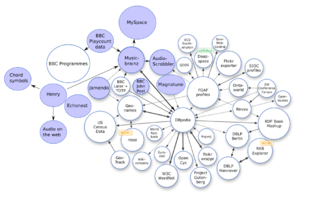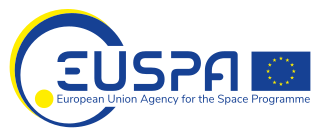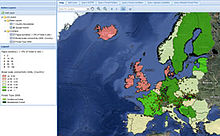
The agencies of the European Union are bodies of the European Union and the Euratom established as juridical persons through secondary EU legislation and tasked with a specific narrow field of work.

Open data is data that is openly accessible, exploitable, editable and shared by anyone for any purpose. Open data is licensed under an open license.

The Publications Office of the European Union is the official provider of publishing services to all EU institutions, bodies and agencies. This makes it the central point of access to EU law, publications, open data, research results, procurement notices, and other official information.
IUCLID is a software application to capture, store, maintain and exchange data on intrinsic and hazard properties of chemical substances. Distributed free of charge, the software is especially useful to chemical industry companies and to government authorities. It is the key tool for chemical industry to fulfill data submission obligations under REACH, the most important European Union legal document covering the production and use of chemical substances. The software is maintained by the European Chemicals Agency, ECHA. The latest version, version 6, was made available on 29 April 2016.
Europa is the official web portal of the European Union (EU), providing information on how the EU works, related news, events, publications and links to websites of institutions, agencies and other bodies. .europa.eu is also used as a common second level domain for the websites of the EU's bodies, for instance iss.europa.eu is the address of the Institute for Security Studies.
A geoportal is a type of web portal used to find and access geographic information and associated geographic services via the Internet. Geoportals are important for effective use of geographic information systems (GIS) and a key element of a spatial data infrastructure (SDI).

Metadata is "data that provides information about other data", but not the content of the data itself, such as the text of a message or the image itself. There are many distinct types of metadata, including:

Europeana is a web portal created by the European Union containing digitised cultural heritage collections of more than 3,000 institutions across Europe. It includes records of over 50 million cultural and scientific artefacts, brought together on a single platform and presented in a variety of ways relevant to modern users. The prototype for Europeana was the European Digital Library Network (EDLnet), launched in 2008.
The Archaeology Data Service (ADS) is an open access digital archive for archaeological research outputs. It is located in The King's Manor, at the University of York. Originally intended to curate digital outputs from archaeological researchers based in the UK's Higher Education sector, the ADS also holds archive material created under the auspices of national and local government as well as in the commercial archaeology sector. The ADS carries out research, most of which focuses on resource discovery, cross-searching and interoperability with other relevant archives in the UK, Europe and the United States of America.

Directive 2003/98/EC on the re-use of public sector information, known as the PSI Directive, now called Open Data Directive, is an EU directive that stipulates minimum requirements for EU member states regarding making public sector information available for re-use. This directive provides a common legislative framework for this area. The Directive is an attempt to remove barriers that hinder the re-use of public sector information throughout the Union.

data.gov.uk is a UK Government project to make available non-personal UK government data as open data. It was launched as closed beta in 30 September 2009, and publicly launched in January 2010. As of February 2015, it contained over 19,343 datasets, rising to over 40,000 in 2017, and more than 47,000 by 2023. data.gov.uk is listed in the Registry of Research Data Repositories re3data.org.
Open scientific data or open research data is a type of open data focused on publishing observations and results of scientific activities available for anyone to analyze and reuse. A major purpose of the drive for open data is to allow the verification of scientific claims, by allowing others to look at the reproducibility of results, and to allow data from many sources to be integrated to give new knowledge.

The Asset Description Metadata Schema (ADMS) is a common metadata vocabulary to describe standards, so-called interoperability assets, on the Web.
The European Legislation Identifier (ELI) ontology is a vocabulary for representing metadata about national and European Union (EU) legislation. It is designed to provide a standardized way to identify and describe the context and content of national or EU legislation, including its purpose, scope, relationships with other legislations and legal basis. This will guarantee easier identification, access, exchange and reuse of legislation for public authorities, professional users, academics and citizens. ELI paves the way for knowledge graphs, based on semantic web standards, of legal gazettes and official journals.
The European Marine Observation and Data Network (EMODnet) is a web portal that brings together marine data, data products and metadata from diverse sources within Europe in a uniform way. It was initiated by the European Commission in response to the EU Green Paper on Future Maritime Policy, launched in June 2006. The main purpose of EMODnet is to unlock fragmented and hidden marine data resources and to make these available to individuals and organisations without restriction, except in special cases. The primary motivation for EMODnet is to stimulate investment in sustainable coastal and offshore activities through improved access to quality-assured, standardised and harmonised marine data.
Data Catalog Vocabulary (DCAT) is an RDF vocabulary designed to facilitate interoperability between data catalogs published on the Web. By using DCAT to describe datasets in catalogs, publishers increase discoverability and enable applications to consume metadata from multiple catalogs. It enables decentralized publishing of catalogs and facilitates federated dataset search across catalogs. Aggregated DCAT metadata can serve as a manifest file to facilitate digital preservation.
On April 21, 2021 data.europa.eu was launched as a single access point for open data published by EU Institutions, national portals of EU Member states and non-member states, as well as international organisations of predominantly European scope. The portal consolidates datasets previously available via the EU Open Data Portal and the European Data Portal into a single meta-catalogue. The European Data Portal, launched in its beta version on November 16, 2015, was an initiative of the European Commission, and part of the Digital Single Market.
In natural language processing, linguistics, and neighboring fields, Linguistic Linked Open Data (LLOD) describes a method and an interdisciplinary community concerned with creating, sharing, and (re-)using language resources in accordance with Linked Data principles. The Linguistic Linked Open Data Cloud was conceived and is being maintained by the Open Linguistics Working Group (OWLG) of the Open Knowledge Foundation, but has been a point of focal activity for several W3C community groups, research projects, and infrastructure efforts since then.

The European Union Agency for the Space Programme (EUSPA) is a space agency, managing the European Union Space Programme as one of the agencies of the European Union (EU). It was initially created as the European Global Navigation Satellite Systems Supervisory Authority (GSA) in 2004, reorganised into the European Global Navigation Satellite Systems Agency in 2010, and established in its current form on May 12, 2021. EUSPA is a separate entity from the European Space Agency (ESA), although the two entities work together closely.

FAIR data are data which meet principles of findability, accessibility, interoperability, and reusability (FAIR). The acronym and principles were defined in a March 2016 paper in the journal Scientific Data by a consortium of scientists and organizations.









